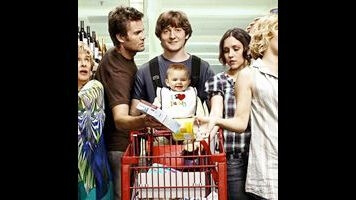Raising Hope

Since 2007, TV Club has dissected television episode by episode. Beginning this September, The A.V. Club will also step back to take a wider view in our new TV Reviews section. With pre-air reviews of new shows, returning favorites, and noteworthy finales, TV Reviews doesn’t replace TV Club—as usual, some shows will get the weekly treatment—but it adds a look at a bigger picture.
At 4 years old, it sometimes seems miraculous that Raising Hope is still on the air. After its 2010 debut, the cult comedy bounced around the Fox schedule, at first looking like it might grow into a modest hit after Glee, then forging out into timeslots that were less and less hospitable to it, from airing after the incompatible New Girl, to leading off Tuesday night without any protection, to finally winding up on Fridays, where it will begin its fourth season this week. The show’s ratings reflected that downward timeslot trajectory, but it hung in there, perhaps because Fox wanted to get it to syndication and perhaps because the network simply likes the show.
It’s right to. Raising Hope has reached the point where it’s past its initial growing pains and where it has more or less figured out what it does well. And while it might not be the most ambitious comedy on the air, pound for pound, it’s one of the funniest, and there are big belly laughs in every one of the four episodes Fox sent out to critics. The series’ ensemble is filled with comedic heavy-hitters, and every single actor knows exactly which beats to hit and just how to hit them.
The primary reason to be concerned about Raising Hope heading into its fourth season is that creator Greg Garcia, the series’ primary creative voice of its first three years, has departed the day-to-day operation of the show to focus on projects for CBS. (That has resulted in The Millers, which is still finding its way.) Garcia previously shepherded Yes Dear and My Name Is Earl to syndication (just barely in the case of the latter, which has often been a point of irritation on Hope), but it’s also not uncommon for showrunners to leave their shows behind in search of new opportunities, usually around the third or fourth season, when things start to get a little stale.
What is at least somewhat uncommon is for a show that’s lost such a key figure in its success to simply chug along, as if nothing has happened. Indeed, the least funny of those four episodes is one of the two holdovers from the show’s third season, ostensibly produced while Garcia was still in charge, and the other three nicely modulate what works about the show when it’s clicking. The broad stuff never gets so broad that the characters become cartoons, which keeps the series from seeming like it’s making fun of its lower-class regular characters. And when the series wants to pivot on a dime and do something with just a hint of “heart,” it can do that, too, without breaking a sweat.
If the series has lost a bit of the swagger it had early in its second (and best) season, that’s likely because its characters are so firmly settled. Now married to longtime love interest Shannon Woodward, Lucas Neff’s main character has become a kind of agreeably lunkheaded sitcom dad. The wacky schemes he and his wife take part in—or even hatch—seem like perfect microcosms of the sorts of things his parents would have done. As those parents, Martha Plimpton and Garret Dillahunt remain one of TV’s most unsung comedic duos, hitting every pitch thrown their way and even finding a few that weren’t aimed at them. If the fourth season has a through-line—always a dangerous thing to look for on a loosey-goosey show like Hope—then it’s about Plimpton and Dillahunt figuring out how to age gracefully. The season premiere features Jeffrey Tambor as a man with an unusual connection to Plimpton, and he’s got far better material—and he garners far bigger laughs—than he did in the fourth season of Arrested Development.
The series, like most sitcoms in their fourth seasons, has lost a bit of the element of surprise. The jokes are mostly expected, but they’re calibrated so well that they rarely become unwelcome. The writers know to keep Cloris Leachman’s inappropriate grandma character lucid most of the time—because she’s much funnier that way—and they know how to use the show’s elaborate cast of guest and recurring characters to full effect. They know when to push the absurdity and oddness of the series and when to dial it back so as not to seem to be mocking the show’s blue collar roots. They even know when to give baby Hope a line or two of dialogue. (Many series with the premise of a bumbling everyman ending up with a baby with this sort of cartoonish tone might have kept that baby a baby. It’s to this show’s credit that Hope is now a toddler.)
The rap against Raising Hope when it debuted was that it was about a bunch of clowns who had no business being at the middle of a series that tried to tug at the heartstrings every so often, that the show was making fun of blue-collar folks by showing how they would be so dumb as to endanger a baby. But the longer the show goes on and the more settled it becomes, the more it seems to be less about clowning around and more about maturation, about what it means to grow into the best possible version of yourself with the help of your family and friends you find along the way. The series’ pilot now is less like a bad starting point and more like the awkward throat clearing before the growing up can begin. Like any show in its fourth season, Raising Hope is showing its age, but that may be by design.